Biocatalyst Market Research, 2032
The global biocatalyst market was valued at $1.1 billion in 2022, and is projected to reach $2.1 billion by 2032, growing at a CAGR of 6.7% from 2023 to 2032.
A biocatalyst is a type of catalyst that is derived from a biological source, typically enzymes or whole cells. Enzymes are protein molecules that act as catalysts in biochemical reactions, accelerating the conversion of substrates into products. They are highly specific and efficient in their catalytic activity. Biocatalysis is the process of using these biological catalysts to perform chemical transformations. Enzymes can catalyze a wide range of reactions, including but not limited to the breakdown of complex molecules, synthesis of new molecules, and modification of existing molecules. They can work under mild reaction conditions, such as ambient temperature and pressure, which is advantageous from an environmental and energy perspective.
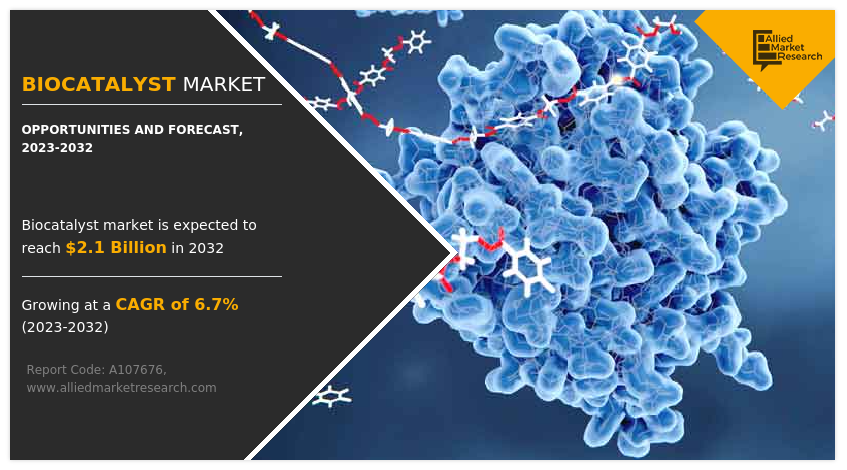
Biocatalysts have gained significant attention and application in various industries, including pharmaceuticals, food and beverages, biofuels, and agriculture. They offer several advantages over traditional chemical catalysts, such as higher selectivity, milder reaction conditions, and the ability to work with complex substrates. Biocatalysis is often considered a greener and more sustainable alternative to conventional chemical processes.
Researchers and scientists are actively exploring and engineering new biocatalysts to expand their range of applications. This includes modifying existing enzymes through protein engineering techniques or discovering novel enzymes from extremophilic organisms (organisms that thrive in extreme environments). The field of biocatalysis continues to evolve, with ongoing advancements in enzyme discovery, optimization, and application in various industrial processes.
Increase in demand from phrmaceutical industry
The biopharmaceutical industry, including the production of therapeutic proteins, antibodies, and pharmaceutical intermediates, is experiencing significant growth. Biocatalysts play a crucial role in these processes by enabling efficient synthesis, modification, and purification of biologically active compounds. The increasing demand for biopharmaceuticals is driving the adoption of biocatalysts in this sector. Biocatalysts offer a more environmentally friendly alternative to traditional chemical catalysts. They are derived from renewable resources and generally operate under mild reaction conditions, reducing energy consumption and waste generation.
Biocatalysts are highly specific in their activity, enabling selective transformations and reducing unwanted byproducts. They can often perform complex reactions in a single step, eliminating the need for multiple chemical steps. Although the initial development and production of biocatalysts can be expensive, they often provide cost advantages in the long run. Their high selectivity reduces the need for purification steps, and they can be recycled and reused, leading to overall cost savings.
Advances in genetic engineering and biotechnology have facilitated the development and optimization of biocatalysts. Through techniques like protein engineering, scientists can modify and enhance the properties of enzymes to suit specific applications, expanding the range of reactions that can be catalyzed by biocatalysts. However, Biocatalysts can sometimes be expensive to produce or purify, making them less economically viable compared to traditional chemical catalysts.
The high production costs may limit their adoption in certain industries or applications. In addition, biocatalysts, particularly enzymes, can have limited stability and shelf life, especially under harsh operating conditions. This limitation may restrict their use in processes requiring prolonged operation or in industries that demand long shelf life for their products.
Biocatalysts play a crucial role in promoting green chemistry practices by replacing traditional chemical catalysts, which often involve hazardous substances and generate harmful waste. The increasing emphasis on sustainable and environmentally friendly processes creates a favorable environment for the biocatalyst market. The shift towards renewable energy sources and the need for sustainable chemicals have opened doors for biocatalysts in the biofuels and renewable chemicals sector. Biocatalysts can aid in the production of biofuels such as biodiesel and bioethanol and facilitate the conversion of biomass into valuable chemicals.
The biocatalyst market is segmented into the source, type, end-use industry, and region. On the basis of source, it is categorized into plant, animal, and microorganism. By type, the market is classified into oxidoreductases, transferases, hydrolases, and others. End-use industry covered in the report are pharmaceutical, food & beverage, water treatment, biofuel, and others. Region-wise, the market is studied across North America, Europe, Asia-Pacific, and LAMEA.
The major players operating in the global biocatalyst market include Novozymes, DuPont, DSM, Codexis, BASF SE, Lonza, Amano Enzyme Inc., Dyadic International Inc., Biocatalysts Limited, and Piramal Pharma Solutions. Other players include AB Enzymes, Prozomix Limited, Chr Hansen Holding A/S, and evoxx technologies GmbH.
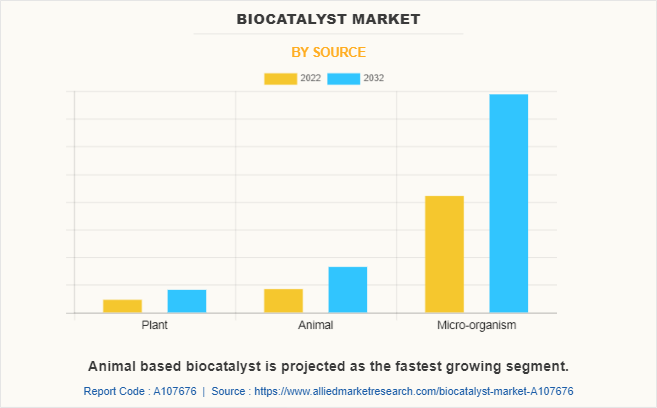
The micro-organism segment accounted for the largest share of the biocatalyst market. The use of microorganism-based biocatalysts offers several advantages over traditional chemical catalysts. They are often more specific, efficient, and environmentally friendly. Moreover, these biocatalysts can be optimized through genetic engineering or evolutionary processes to enhance their catalytic properties and broaden their range of applications. Microorganism-based biocatalysts offer a more sustainable alternative to traditional chemical catalysts.
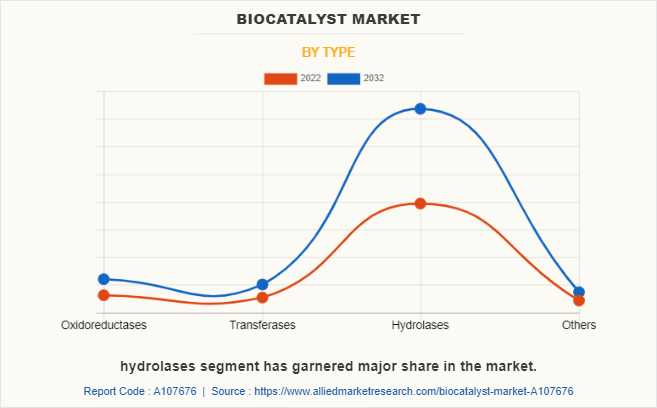
The hydrolases segment accounted for the major share of the biocatalyst market. The field of biotechnology relies heavily on hydrolases for various applications. Enzymes are used in biocatalysis, where they enable specific chemical reactions under mild conditions, thereby reducing energy consumption and waste generation. As enzyme engineering techniques improve, there is an increased demand for tailored hydrolases with enhanced properties, such as higher activity, specificity, stability, or resistance to harsh conditions. These factors are driving the demand for hydrolases.
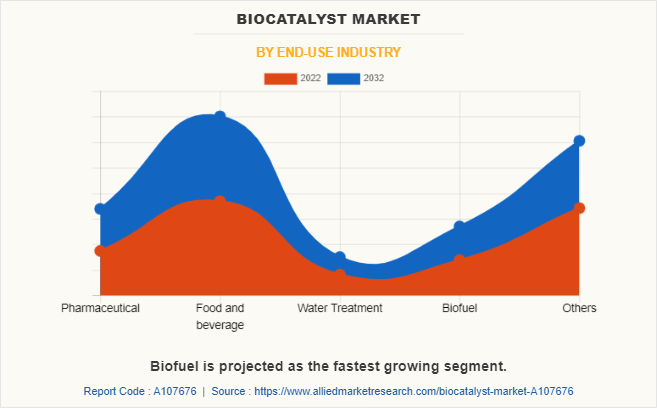
The food and beverage industry has garnered a major market share. Biocatalysts are employed in the production of various dairy products. Enzymes like rennet are used in cheese-making to coagulate milk proteins, aiding in curd formation and separation from whey. Lactase is another important enzyme used to break down lactose in milk, making it suitable for lactose-intolerant individuals. These factors are driving the demand for biocatalysts in the food and beverages industry.
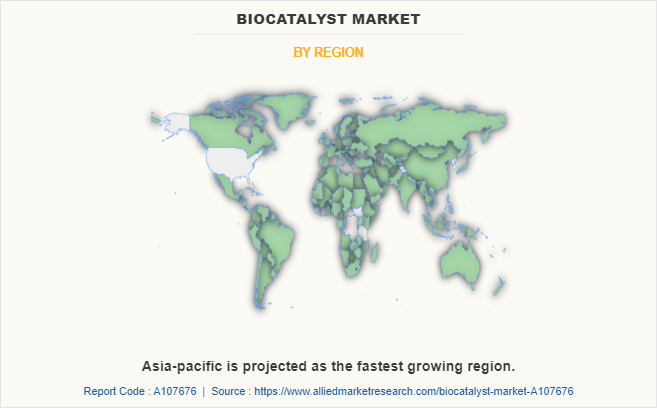
Asia-Pacific has garnered the highest market share and is projected as the fastest-growing region. Enzymes play a crucial role in processes like chiral synthesis, resolution of enantiomers, and stereoselective transformations. Biocatalysts are employed in China's food and beverage industry for various applications such as flavor production, food processing, and modification of ingredients. For example, enzymes like proteases, amylases, and lipases are used for improving the texture, taste, and nutritional value of food products.
Key Benefits For Stakeholders
- This report provides a quantitative analysis of the market segments, current trends, estimations, and dynamics of the biocatalyst market analysis from 2022 to 2032 to identify the prevailing biocatalyst market opportunities.
- Market research is offered along with information related to key drivers, restraints, and opportunities.
- Porter's five forces analysis highlights the potency of buyers and suppliers to enable stakeholders to make profit-oriented business decisions and strengthen their supplier-buyer network.
- An in-depth analysis of the biocatalyst market segmentation assists to determine the prevailing market opportunities.
- Major countries in each region are mapped according to their revenue contribution to the global market.
- Market player positioning facilitates benchmarking and provides a clear understanding of the present position of the market players.
- The report includes an analysis of the regional as well as global biocatalyst market trends, key players, market segments, application areas, and market growth strategies.
Biocatalyst Market Report Highlights
| Aspects | Details |
| Market Size By 2032 | USD 2.1 billion |
| Growth Rate | CAGR of 6.7% |
| Forecast period | 2022 - 2032 |
| Report Pages | 372 |
| By Source |
|
| By Type |
|
| By End-use industry |
|
| By Region |
|
| Key Market Players | Prozomix Limited, Codexis, Inc., DuPont de Nemours, Inc., BASF SE, AB Enzymes, Novozymes, DSM, Amano Enzyme Inc., Biocatalysts, Lonza |
Analyst Review
According to the insights of the CXOs of leading companies, the biocatalyst market is subject to various regulatory frameworks governing safety, efficacy, and environmental impact. Companies closely monitor and navigate these regulations to ensure compliance and avoid any potential setbacks or delays in product development and commercialization. Continuous investment in research and development is crucial to stay competitive in the biocatalyst market. It is important to foster a culture of innovation, collaborate with academic institutions and research organizations, and explore partnerships or acquisitions to access cutting-edge technologies and expand the product portfolio. Companies must identify unique selling propositions and differentiators to get major market share in biocatalyst market. This involves focusing on specific industrial applications, customizing solutions for customer needs, or leveraging proprietary technologies. Creating a strong brand and building customer trust are critical to gaining a competitive edge.
Increasing demand from the biofuel industry is the upcoming trend in the biocatalyst market.
The food and beverage industry is the leading industry of biocatalyst market.
Asia-Pacific is the largest regional market for biocatalysts.
The Biocatalyst Market was valued at $1.1 billion in 2022 and is estimated to reach $2.0 billion by 2032, exhibiting a CAGR of 6.7% from 2023 to 2032.
The major players operating in the global biocatalyst market include Novozymes, DuPont, DSM, Codexis, BASF SE, Lonza, Amano Enzyme Inc., Dyadic International Inc., Biocatalysts Limited, and Piramal Pharma Solutions.
Loading Table Of Content...
Loading Research Methodology...



